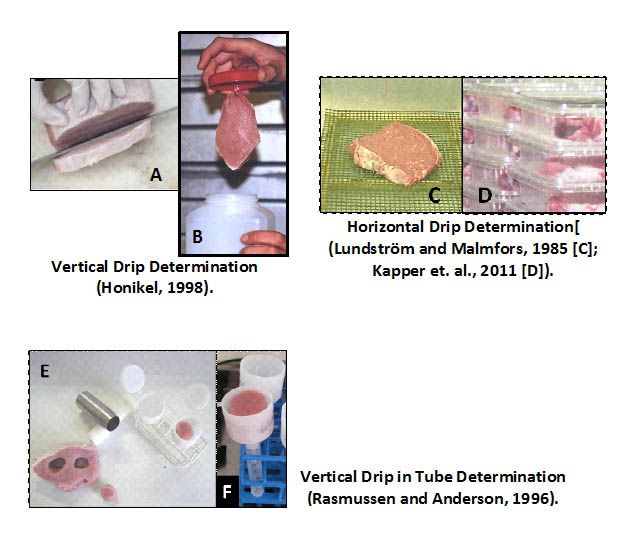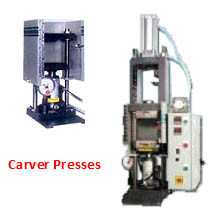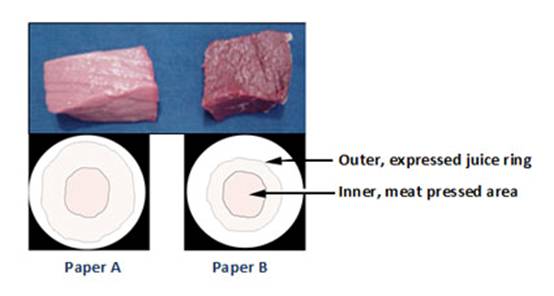Methods for Measuring WHC of Meat
There are numerous analytical methodologies that measure very accurately the dynamics of water in biological systems. However, many methods, such as osmotic pressure, relative vapor pressure, adsorption isotherms, solvent vs. non-solvent water, differential thermo analysis, and water activity provide excellent data on some aspects of water, but have not yet provided solid quantitative or qualitative data directly related to WHC.
The WHC methodologies that have been most consistent and useful in previous research are characterized below. There have been a large number of "unique" variations applied to each basic method.
- Gravimetric: The simplest methods where weight loss is determined without application of external forces. Methods involve drip losses from suspension of samples with specified geometry, weight, and fiber orientation during hanging in a bag or beaker at atmospheric pressure, and uniform temperature and time (1 to several days). Numerous variations of this method have been described.
- Advantages: Simple, little investment, great analytical skills not required, done properly, results are sensitive and reproducible.
- Limitations: Slow, requires removal of sample, additional background information on animal and processing history is very beneficial (see section II).
- Note: If meat sample A (shown in Fig. V-2 below) was used for gravimetric WHC testing; it would be more desirable to have the fiber orientation parallel to the long axis.

Figure V-1. Depictions of several WHC Methods.
A: Cutting samples for trays that are uniformly thick with controlled fiber orientation.
B: Vertical drip in jar (a bag or covered beaker). Meat is not touching container.
C and D: Horizontal chop drip losses.
E: Coring devise should be aligned parallel to the muscle cell orientation for vertical drip or for centrifuge WHC.
F: Tubes for centrifuge WHC.
- Application of an external force: Various forces such as pressure, centrifugal, capillary, negative pressure (vacuum) are applied to samples to speed up (usually minutes to an hour) the gravimetric methods.
- Filter paper press method has been widely evaluated and used. A specified amount and geometry of sample is placed on humid filter paper that is placed between to Plexiglas plates and subjected to a specified pressure for a given time.

- Advantages: Fast (less than 30 min), can run multiple samples at a time, and relatively simple and easy to do. There are several variations to choose from.
- Limitations: Requires some knowledge of the history of the sample (post-mortem time, pH, and packaging conditions). The filter paper press method is not highly correlated to drip loss, but has been a useful relative indication of WHC.
The filter paper method of Kauffman et al (1986a) shown in the video is a blend of gravimetric principles combined with weak absorptive forces.

Figure V-2. Meat and filter papers from a press method for WHC. The smaller inter ring is the pressed meat ring and the larger, outer circle is the boundary of fluid expressed from the meat at a given force.
Expression of filter paper WHC can be confusing, for example:
- For paper A: The ratio of meat area to expressed juice area would be low and indicative of a low WHC. Here a lower value is not desired.
- For paper A: The ratio of expressed juice area to meat area would be high and indicative of a low WHC. Here a higher value is not desired.
- For Paper B: The values for the ratios for paper B would be opposite to Paper A, respectively and would be indicative of greater WHC.
- Depending on how the WHC is calculated, larger values can indicate low or high WHC. One must be very careful to check the ratios used so that interpretations of the WHC data are correct.
-
Centrifugal forces methods have also been widely evaluated. A specified amount and geometry of sample is placed in a centrifuge tube and subjected to specified g-forces at a specified temperature and time.
- Advantages: Fast (60 min, depending centrifuge run time), can run multiple samples at a time, and relatively simple and easy to do. There are several variations to choose from including those applicable to processed meats.
- Limitations: Requires some knowledge of the history of the sample (post-mortem time, pH, and packaging conditions, see Section II). High speed centrifuge required for highest correlations, low speed methods need some specialized centrifuge tubes to get better correlations with drip. Limited in a similar way as filter paper press method.
- Applying Heat: Cooking for drip loss determination fits into an entirely different application of WHC compared with the fresh meat methods. The amount of weight loss for nearly all methods of thermal processing and can be determined with results that directly apply to cook yields. Numerous variants of small, laboratory methods are available that relate well to oven or smoke house yields of fresh or further processed products. Many researchers have used whole steaks or chops of meat to determine the % cooking loss as an indicator of WHC. However, care must be taken to check how representative the cooked is of the total water that was originally present in the cut. In other words, did the cooked cut lose some of its water during storage, display, freezing and thawing? If so, the WHC is over estimated and misleading.
- Advantages: Direct industry application, often done for tracking of yields (but not always related to WHC), calculations are familiar to many operations, and data can be handled electronically. Rather fast and delivers a good relationship to the product when collected in large quantities such as complete batches of smoke-house cooked product.
- Limitations: The times of heating and final temperature are difficult to match with the time/temperature conditions in larger pieces. Must control as many raw processing, cooking, and chilling variables as possible to maintain accuracy and precision.